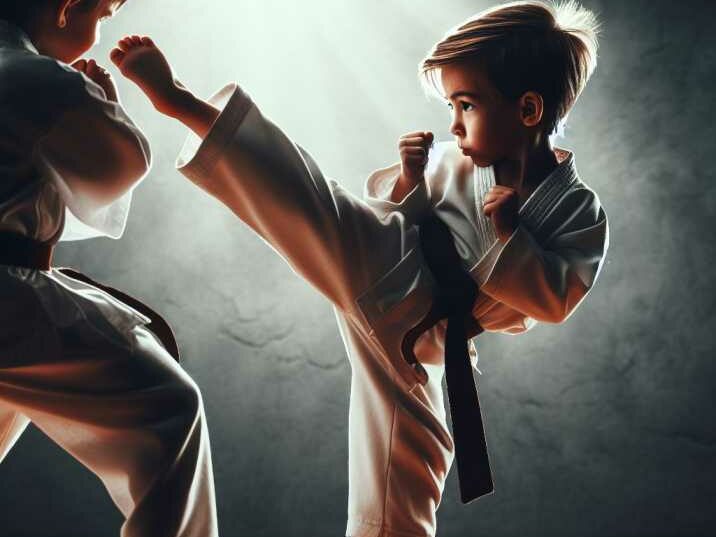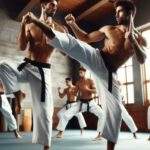Introduction:
Table of Contents
Are you someone who embodies the saying “small but mighty”? Do you believe that strength comes in all sizes? If you’re nodding along, then you’re in for a treat! In this extensive guide, we embark on a journey to uncover the ultimate martial art for someone small and lightweight in stature but colossal in determination.

Embracing Your Physical Advantage
Embrace Your Size:
Being small and lightweight can be a tremendous asset in martial arts. Your agility, speed, and ability to maneuver swiftly can give you a significant edge over larger opponents.
Leverage Your Center of Gravity:
Your lower center of gravity grants you better balance and stability, making it harder for opponents to knock you off your feet. Utilize this to your advantage in various martial arts techniques.
Exploring Best Martial Art for Someone Small and Lightweight
Brazilian Jiu-Jitsu (BJJ)
Renowned for its emphasis on leverage and technique over brute strength, Brazilian Jiu-Jitsu (BJJ) is an excellent choice for smaller practitioners. Learn how to use leverage and submissions to control and overcome larger opponents.
Muay Thai
Known as the “Art of Eight Limbs,” Muay Thai emphasizes striking with fists, elbows, knees, and shins. Despite its focus on striking, Muay Thai’s techniques can be adapted to suit smaller individuals, allowing them to effectively defend against larger opponents.
Taekwondo
With its emphasis on speed, agility, and precise techniques, Taekwondo is well-suited for individuals who are small and nimble. Mastering Taekwondo’s kicks and footwork can give you a distinct advantage in combat situations.
Training Strategies for Small Practitioners
Focus on Technique:
Instead of relying solely on strength, prioritize mastering the proper technique in your chosen martial art. Precision and finesse can often overcome raw power.
Develop Core Strength:
Strengthening your core muscles is essential for maintaining balance and stability, especially when facing larger opponents. Incorporate exercises like planks, Russian twists, and leg raises into your training regimen.
Practice Evasion Techniques:
Learning how to evade attacks effectively is crucial for smaller individuals. Work on improving your footwork, head movement, and defensive maneuvers to minimize the impact of your opponent’s strikes.
Overcoming Challenges as a Small Martial Artist
Building Confidence:
Confidence plays a significant role in martial arts success. Believing in your abilities and focusing on continuous improvement can help you overcome any doubts or insecurities.
Finding the Right Training Partner:
Training with partners who are larger and stronger than you can be beneficial for your growth as a martial artist. However, it’s essential to find partners who are willing to adjust their intensity and techniques to match your size and skill level.
Adapting Martial Arts for Self-Defense
Street Self-Defense:
While traditional martial arts training is valuable, it’s essential to adapt your techniques for real-world self-defense situations. Focus on practical techniques that can help you defend yourself against larger, more aggressive attackers.
Awareness and Prevention:
Self-defense goes beyond physical techniques; it also involves awareness and prevention strategies. Stay vigilant of your surroundings and learn how to de-escalate potentially dangerous situations before they escalate.
Harnessing the Power of Agility
Celebrating Nimbleness:
Agility is not just about physical speed; it’s also about mental quickness and adaptability. Small and agile practitioners excel in swiftly changing tactics and exploiting openings in their opponents’ defense.
Embracing Adaptability:
Agility allows you to fluidly transition between offensive and defensive maneuvers, making it challenging for your opponent to anticipate your next move.
Agility Drills:
Incorporate specific agility drills into your training routine to enhance your responsiveness and coordination. These drills can include ladder drills, cone drills, agility ladder exercises, and reactive agility drills.
Mastering Brazilian Jiu-Jitsu (BJJ)
The Art of Leverage:
In BJJ, leverage is not just about physical strength; it’s about using your opponent’s momentum against them. By understanding leverage, smaller practitioners can efficiently control and submit larger opponents.
Ground Control Dominance:
BJJ emphasizes positional dominance on the ground. Small practitioners can use their agility and technique to maintain advantageous positions and execute submissions.
Guard Techniques:
Guard techniques are essential for smaller practitioners in BJJ. By mastering various guard positions such as closed guard, butterfly guard, and spider guard, you can effectively defend against larger opponents and launch counterattacks.
Embracing the Precision of Taekwondo
Agility in Motion:
Taekwondo’s dynamic kicks and footwork require exceptional agility and timing. Small practitioners excel in executing fast and precise techniques, capitalizing on openings in their opponent’s defense.
Precision Strikes:
Taekwondo practitioners aim to deliver strikes with maximum accuracy and power. Small practitioners can target vulnerable areas such as the head, ribs, and joints to inflict significant damage on larger opponents.
Sparring Drills:
Sparring drills are essential for honing your Taekwondo skills in a controlled environment. Focus on developing your timing, distance management, and defensive abilities through structured sparring sessions with partners of varying sizes and skill levels.

Strategies for Effective Training
Technique Trumps Strength:
While strength can be advantageous, technique is the foundation of martial arts. Small practitioners should prioritize refining their technique to maximize efficiency and effectiveness in combat.
Core Strength Development:
Core strength is essential for maintaining stability and generating power in martial arts techniques. Incorporate exercises such as planks, Russian twists, and medicine ball throws to strengthen your core muscles.
Cross-Training Benefits:
Cross-training in complementary disciplines can enhance your overall martial arts performance. Consider integrating yoga for flexibility, Pilates for core strength, and strength training for power development into your training regimen.
Overcoming Challenges on the Path to Mastery
Cultivating Confidence:
Confidence is built through consistent practice, experience, and positive reinforcement. Set realistic goals, celebrate your progress, and visualize success to boost your confidence as a martial artist.
Finding Supportive Allies:
Surround yourself with training partners and mentors who support your growth and development. Collaborative training sessions and constructive feedback can accelerate your progress and build camaraderie within your martial arts community.
Mental Toughness Training:
Mental toughness is as crucial as physical skill in martial arts. Develop resilience, focus, and mental fortitude through visualization techniques, mindfulness practices, and exposure to challenging situations during training.
Table of Information Related to Different Martial Arts Disciplines:
| Martial Art | Description | Benefits |
|---|---|---|
| Karate | A traditional Japanese martial art focusing on | Improved physical fitness |
| striking techniques such as punches, kicks, and | Enhanced self-defense skills | |
| blocks. | Increased self-confidence | |
| Discipline and mental focus | ||
| Taekwondo | A Korean martial art known for its dynamic | Development of agility and flexibility |
| kicking techniques and fast-paced sparring. | Improved balance and coordination | |
| Stress relief and mental clarity | ||
| Brazilian | A ground-based martial art focusing on | Effective self-defense on the ground |
| Jiu-Jitsu | grappling and submission techniques. | Increased body awareness and control |
| (BJJ) | Builds core strength and endurance | |
| Muay Thai | A striking-based martial art from Thailand | Exceptional cardiovascular conditioning |
| known for its use of fists, elbows, knees, and | Improved reflexes and reaction time | |
| shins. | Teaches mental toughness and discipline | |
| Judo | A Japanese martial art emphasizing throws and | Teaches effective self-defense techniques |
| grappling techniques. | Builds physical strength and endurance | |
| Enhances balance and coordination |
This table provides a brief overview of different martial arts disciplines, including their descriptions and key benefits.
Conclusion
In conclusion, being small and lightweight in the world of martial arts presents unique advantages and challenges. However, with the right mindset, training strategies, and adaptation of techniques, small practitioners can excel and overcome obstacles on their journey to mastery. Embracing agility, leveraging their physical advantages, and focusing on precision and technique are key principles for success.
Exploring martial arts disciplines tailored for smaller individuals such as Brazilian Jiu-Jitsu, Muay Thai, and Taekwondo provides opportunities to capitalize on speed, agility, and technical proficiency. Through consistent training, small practitioners can develop core strength, refine their skills, and enhance their confidence both on and off the mat.
Overcoming challenges requires building confidence, finding supportive allies, and embracing mental toughness. Street self-defense adaptation and awareness of potential threats further empower small practitioners to navigate real-world scenarios effectively.
In essence, martial arts offer a pathway for small individuals to not only defend themselves but also to cultivate physical fitness, mental resilience, and personal growth. By harnessing their unique attributes and embracing the principles of agility, technique, and adaptability, small practitioners can thrive in the world of martial arts and beyond.
FAQs (Frequently Asked Questions)
Which martial art is best for beginners?
Answer: For beginners, martial arts like Karate or Taekwondo are excellent choices due to their structured curriculum and emphasis on foundational techniques.
Is martial arts suitable for children?
Answer: Yes, many martial arts schools offer specialized classes for children, promoting physical fitness, discipline, and confidence in a safe environment.
Can I learn martial arts online?
Answer: While online resources can supplement traditional training, it’s advisable to seek hands-on instruction from qualified instructors for proper technique and safety.
How long does it take to become proficient in a martial art?
Answer: The time to proficiency varies depending on factors such as frequency of training, individual aptitude, and the complexity of the martial art. However, consistent practice over several years is typically required to achieve mastery.
Are martial arts competitions necessary for skill development?
Answer: While competitions can enhance skills such as timing and adaptability, they are not essential for personal growth in martial arts. Many practitioners focus solely on self-improvement and self-defense without engaging in competitive events.


